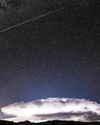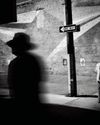Making sense of the “circle of confusion".

DEPENDING ON YOUR PHOTOGRAPHIC INTERESTS, depth of field—the range of distances over which your lens will be sharp—can affect you in either propitious or problematic ways. If you’re trying to isolate one face in a group, a shallow depth of field is just what you need. If you’re hoping to capture the drama of a racehorse beating down the track in your direction, then shallow depth of field can turn much of the equine into a befuddling brown blur, no matter how high your shutter speed.
Frankly, you don’t need to know the science that governs depth of field. You can rely on your preview button or those nifty white marks on your lens barrel. But then again, Napoleon ignored the logistics of marching into Russia, and the results were disappointing. It generally helps to understand what’s going on.
Depth of field is really based on a practical compromise. A perfect lens will bring everything at a given distance into sharp focus at the plane of your camera’s sensor. All subject matter either closer or farther will be unsharp. All of it.
Diese Geschichte stammt aus der November 2016-Ausgabe von Shutterbug.
Starten Sie Ihre 7-tägige kostenlose Testversion von Magzter GOLD, um auf Tausende kuratierte Premium-Storys sowie über 8.000 Zeitschriften und Zeitungen zuzugreifen.
Bereits Abonnent ? Anmelden
Diese Geschichte stammt aus der November 2016-Ausgabe von Shutterbug.
Starten Sie Ihre 7-tägige kostenlose Testversion von Magzter GOLD, um auf Tausende kuratierte Premium-Storys sowie über 8.000 Zeitschriften und Zeitungen zuzugreifen.
Bereits Abonnent? Anmelden

“The Pano Rocks!”
THIS ONE SURE DOES, AND FOR MORE REASONS THAN YOU MIGHT EXPECT

Landscapes In Motion
HOW MICHAEL SHAINBLUM CAPTURES HIS TRULY BREATHTAKING IMAGERY

Shooting Stars
PREPARED FOR A METEOR SHOWER, A PHOTOGRAPHER FINDS THE NIGHT HAS A FEW SURPRISES IN STORE.

Shake It Up
EXPLORE CREATIVE TECHNIQUES TO ADD VARIETY TO YOUR PHOTOS.

Life Lessons
HOW INSTAGRAM AND AN IPHONE TURNED A HOBBY INTO A SECOND CAREER

Shutter To Think
EVERYTHING YOU ALWAYS WANTED TO KNOW ABOUT CAMERA SHUTTERS BUT WERE AFRAID TO ASK

Monochrome Master
THE BLACK-AND-WHITE MAGIC OF MAX VADUKUL

True Grit
CAPTURING AMERICAN TRADITIONS IN TIMELESS BLACK-AND-WHITE IMAGES.

Treasure Chest
WHAT’S THE REAL ATTRACTION—THE PHONE’S CAMERA OR THE CREATIVITY OF ITS APPS?

Invisible Man
HOW DAVID INGRAHAM TAKES STREET PHOTOGRAPHY BEYOND TRADITION.